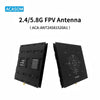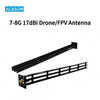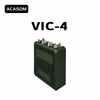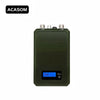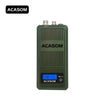How About Powerful Dual-Band Drone Signal Jammer VIC-2?
In today’s rapidly evolving technological landscape, drones have become integral to numerous industries, from security and surveillance to entertainment and logistics. However, their increasing prevalence has also raised concerns regarding unauthorized drone activities, particularly in sensitive areas. This is where the VIC-2, a state-of-the-art drone signal jammer, steps in. Specifically designed to disrupt drone communication and video transmission signals, the VIC-2 ensures security personnel, law enforcement, and military units maintain control over airspace.
In this article, we’ll explore the working principles of the VIC-2 and delve into its key features, including its dual-band technology, portability, and applications for safeguarding sensitive infrastructure.
What is the VIC-2?
The VIC-2 is a highly effective two-band drone signal jamming device that operates within the 700MHz to 1100MHz frequency range. It is engineered to interfere with both the control signals that direct the drone and the video transmission signals that relay live footage back to the operator. This dual-band interference makes the VIC-2 an invaluable tool for neutralizing potential drone threats in environments like military bases, airports, critical infrastructure sites, and more.
With a range capable of disabling unauthorized UAVs, the VIC-2 serves as a reliable solution to prevent drones from carrying out reconnaissance, surveillance, or other malicious activities in no-fly zones. Its versatility and efficiency make it a must-have tool for law enforcement and military personnel.
Working Principles of the VIC-2
The VIC-2 uses advanced technology to target specific frequency bands used by drones for communication and video transmission. Let’s break down how it works:
1. Dual-Band Jamming Technology
The VIC-2 operates on two critical frequency bands:
- 700MHz to 800MHz: These frequencies are commonly used for drone control signals, which are responsible for relaying commands from the drone operator to the UAV.
- 5.2GHz to 5.3GHz: This range is typically used for video transmission, allowing the drone to send real-time footage back to its operator.
By targeting both of these bands simultaneously, the VIC-2 can effectively block communication between the operator and the drone. This ensures that drones lose both their ability to receive commands and to transmit live footage, rendering them ineffective in executing their mission.
2. Interference Mechanism
The VIC-2 works by emitting powerful electromagnetic signals that interfere with the frequency channels used by drones. These signals are strong enough to overpower the drone’s communication signals, causing a loss of connection. Once the drone is jammed, it will typically either return to its takeoff point (autonomous return-to-home feature) or simply fall from the sky.
3. Long-Range Jamming
The VIC-2 is designed for long-range jamming, making it highly effective in preventing drones from operating within a large radius of sensitive sites. This ensures that security personnel can detect and neutralize potential threats even before the drone reaches its intended target. The range of the VIC-2 can vary based on environmental conditions, but it can typically cover distances of up to several kilometers, depending on the power setting and the type of drone being jammed.
4. Minimal Power Consumption and Portability
Despite its powerful jamming capabilities, the VIC-2 is engineered for energy efficiency, allowing for extended use in the field. This is crucial for situations where power sources may be limited, such as during military operations or security patrols in remote areas. Its compact design makes it highly portable, enabling quick deployment in various environments.
The device is also weather-resistant, ensuring reliable performance even in challenging outdoor conditions, such as rain, snow, or extreme temperatures. Whether you're dealing with urban surveillance, border patrol, or critical infrastructure protection, the VIC-2 can withstand the elements.

Applications of the VIC-2
The VIC-2 is widely applicable across a range of industries, where it serves as an essential tool for maintaining control over airspace and protecting sensitive locations.
1. Military Operations
In military operations, unauthorized drones can pose serious risks by providing enemy forces with real-time intelligence or conducting surveillance on sensitive operations. The VIC-2’s ability to neutralize these threats makes it an invaluable asset for military personnel tasked with securing military bases, forward operating bases, and other critical sites.
By ensuring that drones cannot operate in these areas, the VIC-2 prevents potential reconnaissance or hostile actions by adversaries.
2. Law Enforcement and Security
For law enforcement and security personnel, the VIC-2 is an essential tool for countering the increasing threat of drones used for illegal surveillance or even smuggling operations. Drones have been used in various criminal activities, from spying on government buildings to transporting illegal goods into prison yards. The VIC-2 allows security forces to protect sensitive infrastructure such as prisons, government facilities, and public events.
3. Critical Infrastructure Protection
Drones have been identified as a potential security risk to critical infrastructure such as airports, power plants, and telecommunications hubs. The VIC-2 provides a proactive solution by creating a jamming zone around these infrastructures, preventing drones from gathering intelligence or interfering with operations.
4. Anti-Surveillance
In addition to blocking drone control signals, the VIC-2 also disrupts video transmission, which is particularly useful for thwarting unauthorized surveillance. Whether for government agencies, private security companies, or individuals concerned about privacy, the VIC-2 ensures that drones cannot transmit live footage to their operators, rendering any attempted surveillance ineffective.
Table: Types of Drone Signal Boosters
To better understand the different tools available for controlling drone communication, we’ve compiled a table comparing various types of drone signal boosters and jammers, including the VIC-2.
| Device Type | Frequency Range | Target Signal | Primary Use | Range | Portability | Power Consumption |
|---|---|---|---|---|---|---|
| VIC-2 | 700MHz–1100MHz (Dual Band) | Control & Video Signals | Military, Law Enforcement, Security | Long-range | Highly Portable | Low |
| VIC-3 (Signal Booster) | 2.4GHz, 5.8GHz | Drone Control Signals | Enhance drone range for commercial use | Medium-range | Portable | Moderate |
| VIC-4 (Portable Jammer) | 1.5GHz–6.0GHz | All Drone Signals | Personal security, Counter-surveillance | Short to Medium | Very Portable | Low |
| VIC-5 (Long Range Jammer) | 900MHz–2.5GHz | Control Signals | Critical infrastructure protection | Very Long-range | Medium | Moderate to High |
Conclusion
The VIC-2 drone signal jammer is a powerful, versatile tool designed to counter unauthorized drone activities in sensitive areas. With its dual-band jamming technology, long-range effectiveness, and portability, it provides an essential solution for military, law enforcement, and infrastructure security. Whether used to prevent surveillance, protect critical sites, or neutralize potential threats, the VIC-2 ensures a secure environment free from unwanted drone interference.

